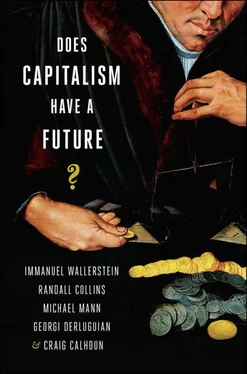Immanuel Wallerstein - Does Capitalism Have a Future?
Здесь есть возможность читать онлайн «Immanuel Wallerstein - Does Capitalism Have a Future?» весь текст электронной книги совершенно бесплатно (целиком полную версию без сокращений). В некоторых случаях можно слушать аудио, скачать через торрент в формате fb2 и присутствует краткое содержание. Город: New York, Год выпуска: 2013, ISBN: 2013, Издательство: Oxford University Press, Жанр: Публицистика, sci_economy, на английском языке. Описание произведения, (предисловие) а так же отзывы посетителей доступны на портале библиотеки ЛибКат.
- Название:Does Capitalism Have a Future?
- Автор:
- Издательство:Oxford University Press
- Жанр:
- Год:2013
- Город:New York
- ISBN:978-0-19-933084-3
- Рейтинг книги:5 / 5. Голосов: 1
-
Избранное:Добавить в избранное
- Отзывы:
-
Ваша оценка:
- 100
- 1
- 2
- 3
- 4
- 5
Does Capitalism Have a Future?: краткое содержание, описание и аннотация
Предлагаем к чтению аннотацию, описание, краткое содержание или предисловие (зависит от того, что написал сам автор книги «Does Capitalism Have a Future?»). Если вы не нашли необходимую информацию о книге — напишите в комментариях, мы постараемся отыскать её.
Does Capitalism Have a Future? — читать онлайн бесплатно полную книгу (весь текст) целиком
Ниже представлен текст книги, разбитый по страницам. Система сохранения места последней прочитанной страницы, позволяет с удобством читать онлайн бесплатно книгу «Does Capitalism Have a Future?», без необходимости каждый раз заново искать на чём Вы остановились. Поставьте закладку, и сможете в любой момент перейти на страницу, на которой закончили чтение.
Интервал:
Закладка:
Long-Term Structural Trends
How does one accumulate capital endlessly in a capitalist system? The basic method, albeit not the only one, is via production, in which the entrepreneur-producer retains the differential between what it costs to produce the commodity and the price at which the producer can sell it. The lower the costs and the higher the sales price, the more profit is realized and can then be reinvested.
But how can the differential between costs and sales price be maximized? There are two necessary elements in this exercise. To maximize sales price, there must be a quasi-monopoly, a subject we have already treated. It is how one in addition minimizes costs that we must now discuss. We start with the reality that there are always three generic costs in any productive process. These are personnel costs, the costs of inputs, and taxation.
There are three different levels of personnel for whom the producer/owner has to pay: the unskilled and semiskilled workforce, the skilled workers and supervisory cadres, and the top managers. The costs of the least skilled workforce tend to go up in A-phases, as they collectively make demands on the employer in one form or other of syndical action. Employers during A-phases may make concessions to the least skilled personnel because avoiding shutdowns or slowdowns may be less costly than wage increases. However, eventually these costs become too high for the employers, particularly for those in the leading industries.
The solution for employers has historically been the runaway factory, that is, relocation to “historically” lower-wage areas during the B-period. There the workers are recruited from loci (usually rural) in which their real income is even lower than that offered by the newly installed (usually urban) production site. It seems to be a win-win situation for the worker and the employer. After some time, however, the transplanted workers feel more knowledgeable about their new situation and more aware of the low level of their wages in worldwide terms. They begin to engage in some syndical action. And sooner or later the employer finds that, as a result, the costs have again become too high. The solution is still another move.
The moves are costly but effective. Worldwide there is, however, a ratchet effect. The reductions never eliminate totally the increases. Over 500 years, this repeated process has virtually exhausted the loci into which to move. This can be measured by the degree of deruralization of the world-system, which has risen spectacularly in the last fifty years and seems to be proceeding apace.
The increase in the costs of cadres is the result of two different considerations. One, the constantly increased scale of productive units requires more intermediate personnel to coordinate it. And two, the political dangers that result from the repeated syndical organization of the relatively low-skilled personnel are countered by the creation of a larger intermediate stratum who can be both political allies for the ruling stratum and models of a possible upward mobility for the unskilled majority, thereby blunting its political mobilization. Their salaries significantly increase the overall personnel bill.
The increase in the costs of top managers is the direct result of the increased complexity of entrepreneurial structures—the famous separation of ownership and control. This makes it possible for these top managers to appropriate ever larger portions of the firm’s receipts as rent, thereby reducing what goes to the “owners” (shareholders) as profit or to the firm for reinvestment This last increase was quite spectacular in size during the last few decades.
The costs of inputs have been going up for analogous reasons. Capitalists seek to externalize as many costs as they can. This is an elegant way of saying that they are not paying the full bill for the inputs they use. The three main costs they are able to externalize are the disposal of toxic waste, the renewal of raw materials, and the construction of the necessary infrastructure for transport and communications. Over most of the history of the modern world-system, it was considered normal practice to externalize such costs. It was seldom a concern for political authorities.
In the last few decades, however, the political atmosphere has changed radically. Climate change is a very widely debated issue, as a result of which there has been much demand for “green” and “organic” products. The past “normality” of externalization is a distant memory. The explanation for the new political debate about toxic disposal is rather simple. The world has largely run out of vacant public domains into which to dump waste. This is equivalent in effect to that of the deruralization of the world’s work force, the running-out of new groups of potential low-wage workers. The impact on public health has become high and obvious. The result has been the growth of social movements making demands for environmental cleanup and control.
Secondly, public concern about the renewal of resources—another new political reality—is in large part the consequence of the sharp increase in world population. Suddenly, the world has discovered asset shortages of many kinds, already existing or soon to be felt: energy sources, water, forests, fish, and meat. There is debate about who owns what, who uses what, for what purposes the resources are used, and who pays the bill.
Thirdly, capitalism as a system requires considerable infrastructure. Products produced for sale on the world market must be transported. Communication is a crucial element in commerce. Transport and communication are today far more efficient and much, much faster. But this has also meant that the costs have risen considerably. Who pays for this? In the past, the producers who have made the most use of the infrastructure have paid only a small part of the bill. The general public has paid the rest.
Today there is strong political demand that governments assume a new direct role in ensuring detoxification, resource renewal, and further infrastructure expansion. This would require that governments increase taxes significantly. In addition, there is no point in doing this if the causes of the negative realities go untouched. This means that governments would need to insist on more internalization of costs by entrepreneurs. Both increased taxes and, even more, requirements for internalization of these costs would cut sharply into the margins of profit of enterprises—a point that is constantly made by the producers.
Finally, taxation in all its forms has been going up over the historical life of the modern world-system. All the multiple political levels of government require taxation, both to pay the personnel and to pay for the expanding services these governments are expected to offer. There is also the expansion of what might be called private taxation—both the corruption of government officials and the predatory demands of organized mafias. Private taxation is a cost to the entrepreneur, just as much as is state taxation. As the size of governmental structures has vastly increased, particularly in the last fifty years, there have been more people to bribe. And as world economic activity has grown, there is ever more room for mafiosi operations.
Still, the biggest source of increased taxation has resulted from the political struggles of the world’s antisystemic movements. Their demands over the past two centuries have brought about the democratization of world politics. The program of popular movements has fundamentally been to obtain from the states three basic guarantees for the citizenry—education, health services, and lifelong revenue flows. The demands for each have steadily expanded in two ways over the past 200 years: the levels of services demanded, and therefore the costs; and the geographical locales in which the demands have been made. These expenditures are what we refer to as the “welfare state”—a form of which is now part of the normal political life of virtually every government in the world, even if the level of what is offered varies, in large part according to the wealth level of the country.
Читать дальшеИнтервал:
Закладка:
Похожие книги на «Does Capitalism Have a Future?»
Представляем Вашему вниманию похожие книги на «Does Capitalism Have a Future?» списком для выбора. Мы отобрали схожую по названию и смыслу литературу в надежде предоставить читателям больше вариантов отыскать новые, интересные, ещё непрочитанные произведения.
Обсуждение, отзывы о книге «Does Capitalism Have a Future?» и просто собственные мнения читателей. Оставьте ваши комментарии, напишите, что Вы думаете о произведении, его смысле или главных героях. Укажите что конкретно понравилось, а что нет, и почему Вы так считаете.












